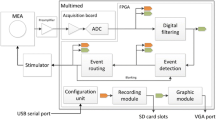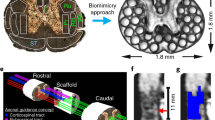Abstract
Neurological disorders affect millions globally and necessitate advanced treatments, especially with an aging population. Brain Machine Interfaces (BMIs) and neuroprostheses show promise in addressing disabilities by mimicking biological dynamics through biomimetic Spiking Neural Networks (SNNs). Central Pattern Generators (CPGs) are small neural networks that, emulated through biomimetic networks, can replicate specific locomotion patterns. Our proposal involves a real-time implementation of a biomimetic SNN on FPGA, utilizing biomimetic models for neurons, synaptic receptors and synaptic plasticity. The system, integrated into a snake-like mobile robot where the neuronal activity is responsible for its locomotion, offers a versatile platform to study spinal cord injuries. Lastly, we present a preliminary closed-loop experiment involving bidirectional interaction between the artificial neural network and biological neuronal cells, paving the way for bio-hybrid robots and insights into neural population functioning.






Similar content being viewed by others
References
Brown T (1914) On the nature of the fundamental activity of the nervous centres; together with an analysis of the conditioning of rhythmic activity in progression and a theory of the evolution of function in the nervous system. J Physiol 48:18–46
Cohen AH et al (1992) Modelling of intersegmental coordination in the lamprey central pattern generator for locomotion. Trends Neurosci 15:434–438
Marder E, Bucher D (2001) Central pattern generators and the control of rhythmic movements. Curr Biol 11:986–996
Ijspeert A et al (2007) From swimming to walking with a salamander robot driven by a spinal cord model. Science 315:1416–1420
Hill AA, Calabrese RL et al (2001) A model of a segmental oscillator in the leech heartbeat neuronal network. J Comput Neurosci 10:281–302
Cymbalyuk GS et al (2002) Cell-autonomous and network-based mechanisms bursting in leech heart interneurons. J Neurosci 22:10580–10592
Matsuo T et al (2008) Biomimetic motion control system based on a CPG for an amphibious multi-link mobile robot. J Bionic Eng 8:91–97
Donati E et al (2014) A spiking implementation of the lamprey’s Central Pattern Generator in neuromorphic VLSI. IEEE BioCAS 2014
Van Der Pol B (1928) The heartbeat considered as a relaxation oscillation, and an electrical model of the heart. Phil Mag 6:763–775
Amari S (1972) Characteristic of the random nets of analog neuron-like elements. IEEE Trans Syst Man Cybern 2:643–657
Ijspeert AJ (2008) Central pattern generators for locomotion control in animals and robots: a review. Neural Netw 21:642–653
Li C, Lowe R, Ziemke T (2013) Humanoids learning to walk: a natural CPG-actor-critic architecture. Front Neurorobot 7:5
Barron-Zambrano JH, Torres-Huitzil C (2013) FPGA implementation of a configurable neuromorphic CPG-based locomotion controller. Neural Netw 45:50–61
Yu J, Tan M, Chen J, Zhang J (2014) A survey on CPG-inspired control models and system implementation. IEEE Trans Neural Netw Learn Syst 25(3):441–456
Qi C et al (2017) A real-time FPGA implementation of a biologically inspired central pattern generator network. Neurocomputing 244:63–80
Izhikevich EM (2004) Which model to use for cortical spiking neurons? IEEE Trans Neural Netw 15(5):1063–1070
Bisio M et al (2019) Closed-loop systems and in vitro neuronal cultures: overview and applications. Adv Neurobiol 22:351–387
Chiappalone M et al (2022) Neuromorphic-based neuroprostheses for brain rewiring: state-of-the-art and perspectives in neuroengineering. Brain Sci 2:8
Rowald A et al (2022) Activity-dependent spinal cord neuromodulation rapidly restores trunk and leg motor functions after complete paralysis. Nat Med 28:260–271
Kathe C et al (2022) The neurons that restore walking after paralysis. Nature 611:540–547
Beaubois R et al (2024) BiœmuS: a new tool for neurological disorders studies through real-time emulation and hybridization using biomimetic Spiking Neural Network. Nat Commun 15:5142
Levi T et al (2018) Study of real-time biomimetic CPG on FPGA: behavior and evolution, International Conference on Artificial Life and Robotics (ICAROB 2018). ALife Robotics Corporation Ltd
Izhikevich EM (2003) Simple model of spiking neurons. IEEE Trans Neural Netw 14(6):1569–1572
Blanchard D, Kohno T, Levi T (2019) Snake robot controlled by biomimetic CPGs, In International Conference on Artificial Life and Robotics (ICAROB 2019. ALife Robotics Corporation Ltd, Oita
Hodgkin AL, Huxley AF (1952) A quantitative description of membrane current and its applications to conduction and excitation in nerve. J Physiol 117:500–544
Pospischil M et al (2008) Minimal Hodgkin–Huxley type models for different classes of cortical and thalamic neurons. Biol Cybern 99:427–441
Khoyratee F et al (2019) Optimized real-time biomimetic neural network on FPGA for bio-hybridization. Front Neurosci 2:13–377
Destexhe A et al (1998) Kinetic models of synaptic transmission. Methods Neuronal Model 2:1–25
Kawada J et al (2017) Generation of a motor nerve organoid with human stem cell-derived neurons. Stem Cell Rep 9:1441–1449
Kirihara T et al (2019) A human induced pluripotent stem cell-derived tissue model of a cerebral tract connecting two cortical regions. Iscience 14:301–311
Osaki T et al (2024) Complex activity and short-term plasticity of human cerebral organoids reciprocally connected with axons. Nat Commun 15(1):2945
Levi T et al (2018) Closed-loop systems for next-generation neuroprostheses. Front Neurosci 2:12–26
Buccelli S et al (2019) A neuromorphic prosthesis to restore communication in neuronal networks. IScience 2:402–414
Grassia F et al (2018) Spike pattern recognition using artificial neuron and spike-timing-dependent plasticity implemented on a multi-core embedded platform. Artif Life Robot 23:200–204
Author information
Authors and Affiliations
Corresponding author
Additional information
Publisher's Note
Springer Nature remains neutral with regard to jurisdictional claims in published maps and institutional affiliations.
This work was presented in part at the joint symposium of the 29th International Symposium on Artificial Life and Robotics, the 9th International Symposium on BioComplexity, and the 7th International Symposium on Swarm Behavior and Bio-Inspired Robotics (Beppu, Oita and Online, January 24–26, 2024).
About this article
Cite this article
Cheslet, J., Beaubois, R., Duenki, T. et al. Biomimetic snake locomotion using central pattern generators network and bio-hybrid robot perspective. Artif Life Robotics 29, 479–485 (2024). https://doi.org/10.1007/s10015-024-00969-0
Received:
Accepted:
Published:
Issue Date:
DOI: https://doi.org/10.1007/s10015-024-00969-0




